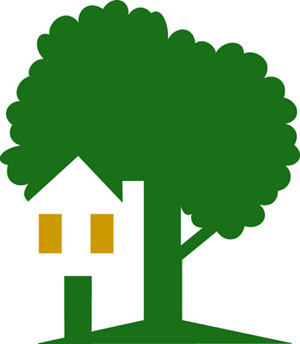
- Introduction
- Fertilization
- Guidelines and Precautions When Fertilizing
- Watering
- Mulching
- Pruning
- Weed Control
- Insect and Disease Management
- Be a Detective When Solving Plant Problems
- Attention! Pesticide Precautions!
Introduction
Most established ornamental plants in the landscape require care to stay healthy and attractive. Regular fertilization, pruning, watering, mulching and pest control are all part of a good landscape management program.
Some plants, such as annual flowers, roses, red-tip photinia and English laurel, are more demanding than others. Annual flowers and roses must be kept well-supplied with nutrients and water at all times, pruned and groomed routinely, and monitored regularly for pests if they are to flower abundantly. Red-tip photinia and English laurel are very susceptible to leaf spot diseases and demand more care.
On the other hand, plants such as ornamental grasses, hollies and junipers, when properly planted on a good site, require little care once established and are considered good low-maintenance plants.
Caring for ornamental plants is more difficult when they are not well-suited to the site selected or when they are improperly planted. Azaleas, for instance, prefer a moist, well-drained soil and shade from the mid-afternoon sun. When planted in poorly drained soil or in full sun without the benefit of irrigation, azaleas become stressed, susceptible to attack from insects and diseases, and require more care. Planting too deeply or too shallowly also causes plant problems.
Today, the concept of low-maintenance landscapes is more popular than ever before. The idea of putting less effort into the landscape without sacrificing quality and beauty is very appealing to a growing number of homeowners and clients of landscape professionals. By applying lower amounts of fertilizer, water and pesticides to the landscape, you not only help the environment but also save time and money. New concepts in low-maintenance landscaping, such as Xeriscaping (water-efficient landscaping) and integrated pest management (control of pests through the selective use of insecticides and encouragement of natural enemies), are proving that it is possible to have a beautiful landscape while saving time, effort and money.
This publication provides guidelines for the care of established ornamental plants in the landscape. Low-maintenance alternatives to traditional cultural practices are discussed throughout the publication.
Start by identifying areas of the landscape that require different amounts of care. A recently planted area, for instance, will generally require more attention than a well-established area. The highly visible public area of the landscape is usually an are where optimum growth is desired at all times, while a secluded, private area requires less maintenance. Once this "zoning" is done and the different levels of plant care are established, landscape maintenance becomes much more efficient and effective.
Fertilization
Fertilization is an important part of landscape maintenance, particularly in urban areas where much of the native topsoil is removed during development and subsoil deficient in essential nutrients becomes the new topsoil.
Unfortunately, fertilization is a rather simple cultural practice made complex and confusing by the wide variety of fertilizer products on the market today -- from "general-purpose" garden fertilizer to specialty products, such as pre-mixed liquid fertilizer concentrates, water-soluble crystals, slow-release fertilizers, azalea/camellia fertilizers and rose specials. Plants generally do not care whether a fertilizer is granulated, liquified, encapsulated, briquetted, pelletized or solubilized! They simply want nutrients in any form they can use.
Fertilizers, however, differ in nutrient content and release duration. The type of fertilizer you select should be based not only on its cost but also on the types of plants being fertilized, the existing nutrient content of the soil, and the type of growth response desired. Liquid or water-soluble fertilizers, for instance, are often used on annuals and herbaceous perennials immediately after transplanting because their nutrients can be absorbed quickly and used by the plant. Woody ornamentals, on the other hand, store food reserves in their roots and do not have an immediate demand for nutrients after transplanting as short-season annuals do. They benefit from slow-release fertilizers that ensure a supply of nutrients as needed.
To determine whether a granular fertilizer has slow-release properties, look at the analysis on the back of the bag. Nitrogen listed in the form of ammoniacal nitrogen indicates that the product has some slow-release property. If the nitrogen is listed as being derived from urea, urea-formaldehyde, IBDU (isobutylenediurea), or sulfur-coated urea, the release duration of the product will be increased. Some granular slow-release fertilizers last six to eight months after application.
Other commonly available slow-release fertilizers on the market include Osmocote granules, Osmocote tablets, Jobe's Spikes, Once, Woodace briquettes, Agriform tablets and Milorganite. These fertilizers generally cost more per pound than general-purpose granular fertilizers such as 10-10-10 or 12-4-8, but they also last longer and don't need to be applied as frequently.
Organic fertilizer sources such as bone meal, cottonseed meal and animal manures can also be used. Table 1 lists the average nutrient content of several organic fertilizer sources. Compost is another good source of slowly available nutrients.
| Table 1. Average nutrient content of various organic fertilizer sources. | |||
|
% Nitrogen
(N) |
Phosphorus
(P2O5) |
% Potash
(K2O) |
|
| Blood, dried |
13.0
|
-
|
-
|
| Bone meal (raw) |
3.5
|
22.0
|
-
|
| Bone meal (steamed) |
2.0
|
28.0
|
-
|
| Cottonseed meal |
6.6
|
2.5
|
1.5
|
| Fish scrap (dried) |
9.5
|
6.0
|
-
|
| Soybean meal |
7.0
|
1.2
|
1.5
|
| Horse manure |
0.7
|
0.3
|
0.6
|
| Cow manure |
0.6
|
0.2
|
0.6
|
| Pig manure |
0.5
|
0.3
|
0.5
|
| Sheep manure |
0.8
|
0.3
|
0.9
|
| Chicken manure |
1.1
|
0.8
|
0.5
|
| Duck manure |
0.6
|
1.4
|
0.5
|
| Source: Soil Fertility and Fertilizers. S.L. Tisdale and W.L. Nelson. MacMillan Publishing Co., 1975. | |||
Which Analysis Is Best?
A soil test, available through your county Extension office, is the best way to determine which fertilizer analysis is best for your soil. As a general guideline, most ornamental plants will benefit from a fertilizer having its primary nutrients (nitrogen, phosphorus and potassium [N-P-K]) in a 3-1-2 or 4-1-2 ratio. A 12-4-8 fertilizer, for instance, is a 3-1-2 ratio, and a 16-4-8 fertilizer is a 4-1-2 ratio. Research shows that phosphorus, the middle number in the analysis, is held be soils and does not leach with rains or irrigation as nitrogen or potassium do; so it is usually needed in lower amounts. On new sites where phosphorus has never been applied, a complete balanced fertilizer such as 8-8-8 or 10-10-10 is sometimes recommended.
When Should You Fertilize?
Research shows that woody plants actively absorb nutrients from the soil during the growing season and require few nutrients during the dormant winter season (see Figure 1). Therefore, apply fertilizer as soon as the plants begin breaking dormancy in the spring, and avoid fertilizing after the first fall frost, which signals plants to begin resting for the winter.
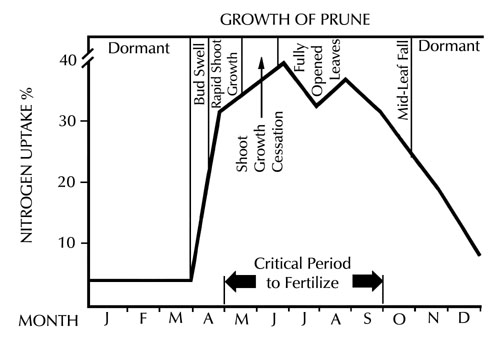 Figure 1. The relationship between nitrate uptake efficiency of non-bearing prune trees and their growth cycle. Source; S.A. Weinbaum, et. al., 1986. J. Amer. Hort. Sci. 111(2): 224-228.
Figure 1. The relationship between nitrate uptake efficiency of non-bearing prune trees and their growth cycle. Source; S.A. Weinbaum, et. al., 1986. J. Amer. Hort. Sci. 111(2): 224-228.
How Often Should You Fertilize and How Much Should You Apply?
The frequency of fertilization depends on the type of plants being fertilized and the type of fertilizer used. If slow-release fertilizers are used, one application should be sufficient for the entire growing season. If general-purpose granular fertilizers are used, two or three applications may be needed, depending on the fertilizer's slow-release properties.
When general-purpose granular fertilizers such as 12-4-8 or 10-10-10 are used on newly-planted ground covers, annuals, herbaceous perennials and roses, light applications made at four- to six-week intervals are recommended.
During periods of limited rainfall or drought, reduce the amount of fertilizer applied and the frequency of application in non-irrigated areas. Fertilizers may injure the roots of ornamentals under drought stress.
Newly-planted ornamental trees and shrubs will benefit from light applications of fertilizer made during the first growing season after transplanting (Table 2). Uniformly broadcast the fertilizer along the perimeter of the planting hole. Avoid using weed-and-feed fertilizers in the vicinity of newly-planted ornamentals because injury from the herbicide may result.
Newly-planted 1-gallon size plants will respond to 1 level teaspoon of a 12 to 16 percent nitrogen fertilizer or a level tablespoon of an 8 to 10 percent nitrogen fertilizer applied in March, May and July. Small trees, fewer than 4 feet tall, should receive no more than 1 tablespoon of a 12 to 16 percent nitrogen fertilizer two to three times during the first growing season. Larger trees will benefit from 3 to 4 tablespoons of a 12 to 16 percent nitrogen fertilizer. Broadcast fertilizer along the perimeter of the planting hole. Remember that newly trans-planted ornamentals are under stress while they are trying to adapt to their new location and they can be easily injured by over-fertilization.
| Table 2. Recommended fertilization rates for newly planted ornamental plants during the first growing season (use only one of the fertilizers listed at the rate recommended). | ||||
|
Application rate1/plant
|
Application frequency | |||
| Plant type/size |
12-4-8
|
16-4-8
|
10-10-10
|
|
| 1-gallon shrubs |
1 tsp.
|
1 tsp.
|
1 tbsp.
|
March, May, July |
| 3-gallon shrubs |
2 tsp.
|
2 tsp.
|
2 tbsp.
|
March, May, July |
| 5-gallon shrubs |
3 tsp.
|
3 tsp.
|
3 tbsp.
|
March, May, July |
| Trees under 4 feet |
1 tbsp.
|
1 tbsp.
|
2 tbsp.
|
March, July |
| Trees 4 to 6 feet |
3 tbsp.
|
3 tbsp.
|
5 tbsp.
|
March, July |
| Trees 6 to 8 feet |
4 tbsp.
|
4 tbsp.
|
6 tbsp.
|
March, July |
|
Application 100/sq. ft
|
Application frequency | |||
|
12-4-8
|
16-4-8
|
10-10-10
|
||
| Ground covers, annuals & herbaceous perennials |
0.5 lb.
|
0.5 lb.
|
1 lb.
|
Each 4 to 6 weeks |
| 1tsp. = level teaspoon; tbsp. = level tablespoon; lb. = pound. When using slow-release or soluble fertilizers, follow label recommendations for application rate. | ||||
The quantity of fertilizer applied on established ornamentals depends on the analysis of the fertilizer used, the area fertilized and the amount of growth desired. Nitrogen controls vegetative growth, so application rates are based on this primary nutrient. Table 3 lists suggested application rates for several general-purpose fertilizers.
DO NOT OVER-FERTILIZE OR FOLIAR DAMAGE MAY RESULT. To increase the application rate, increase the frequency of application, but do not exceed the amount recommended in Table 3 for each application. Optimum growth fertilization rates (three to five applications) are usually used on annuals, herbaceous perennials, roses and newly established ground covers to encourage their spread. Otherwise, low rates of fertilizer are recommended, particularly if you desire a lower maintenance landscape. As the application rate of fertilizer increases, so does the amount of new growth, which requires more water, more fertilizer and more pruning.
| Table 3. Recommended application rates of various general-purpose granular fertilizers on established ornamental plants in the landscape. | |||||||
| Source |
Application rate*
|
||||||
|
1000 sq. ft.
|
100 sq. ft.
|
10 sq. ft.
|
|||||
|
pounds
|
cups
|
pounds
|
cups
|
tablespoons
|
|||
| 10-10-10 |
10.0
|
20
|
1
|
2.0
|
4.0
|
||
| 8-8-8 |
12.5
|
25
|
0.5
|
2.5
|
5.0
|
||
| 13-13-13 |
|
|
|
|
|
||
| 12-3-6 |
6.0
|
12
|
3/4
|
1.5
|
3.0
|
||
| 12-4-8 |
|
|
|
|
|
||
| 12-6-6 |
|
|
|
|
|
||
| 16-4-8 |
6.0
|
12
|
0.5
|
1.0
|
2.0
|
||
| 4-12-12 |
25.0
|
50
|
2.5
|
5.0
|
10.0
|
||
| 5-10-10 |
20.0
|
40
|
2
|
4.0
|
8.0
|
||
| * This rate will supply 1 pound of actual nitrogen per 1,000 square feet. For optimum growth of young shrubs, ground covers and trees, three to five applications are recommended at 6- to 10-week intervals from March to August. Application frequency varies with the amount of slow-release nitrogen in the product, so consult the label for specific recommendations. Established trees and shrubs will benefit from one to two applications during the growing season. Annual flowers and roses should receive applications at 4- to 6-week intervals from March to August. When using slow-release or specialty fertilizers, follow the manufacturer's recommendation on the container. | |||||||
To determine how much fertilizer to apply, first estimate the area to be fertilized. This involves estimating the length and width of a bed in linear feet and multiplying the two numbers to obtain square footage (see Figure 2). Few plant beds are perfectly square or rectangular, so square off the rounded areas to simplify your estimate. Trees growing within a bed can be included in the bed estimate or, if they require special fertilization, estimate their canopy area by measuring the distance from the trunk to the drip line or tip of the branches (this is called the radius). Then use the geometric formula for the area of a circle to calculate the area of the canopy: 3.14 x radius2. For example, if the distance from the main trunk to the drip line of a tree is measured to be 20 feet, the area beneath the canopy is 3.14 x (20 x 20) = 1,256 square feet. See guidelines below for additional recommendations on tree fertilization.
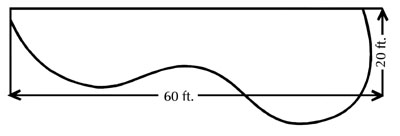 Figure 2. Question - Approximately how many square feet are in this plant bed? Answer - 1,200 square feet.
Figure 2. Question - Approximately how many square feet are in this plant bed? Answer - 1,200 square feet.Guidelines and Precautions When Fertilizing
- Broadcast fertilizer evenly over the bed area. Make certain the foliage is dry when fertilizer is broadcast over the tops of ornamentals.
- If fertilizer becomes lodged in the foliage of ornamentals, brush it off before irrigating.
- It is not necessary to remove the mulch when fertilizing. Broadcast fertilizer on top of the mulch and water it in.
- Trees growing in turf areas will obtain nutrients from the fertilizer that is applied to the turfgrass. Do not apply excess fertilizer to turf in an effort to feed trees; injury to the turf may occur.
- When fertilizing trees, broadcast the fertilizer over an area extending two to three times the canopy spread if possible. Research has shown that tree roots grow far beyond the canopy spread on established trees.
- Do not concentrate fertilizer in holes drilled under tree canopy. Research shows that broadcast application results in better growth.
- An effective technique for fertilizing annual flowers is to place a slow-release fertilizer such as Osmocote in the planting hole directly beneath the plant. This not only provides an even supply of nutrients to the plants, it also decrease the number of weeds when compared to broadcast application.
- Plants growing in shade generally require less fertilizer than those growing in the sun.
- Plants growing in sandy soils generally require more frequent fertilization than those in clay soils due to nutrients leaching from sandy soils.
- Avoid using weed-and-feed lawn fertilizers that contain herbicides near ornamental plants.
Watering
Most ornamental plants in the landscape, once they are established, can go days or even weeks without supplemental irrigation. In fact, over-watering (water too frequently) is a leading cause of problems with ornamentals. Junipers, for example, are extremely drought-tolerant once they are established, but they cannot tolerate extended periods of excess moisture.
Your best guide for determining when to water is the plant itself. Wilting or a pale grayish-green color are the most common symptoms in plants needing water. Certain plants in the landscape -- such as annuals, herbaceous perennials, azaleas and rhododendrons -- need more water than others. By watering only those plants that need water, you not only will save water, time and money, you also avoid watering plants that do not need a lot of moisture.
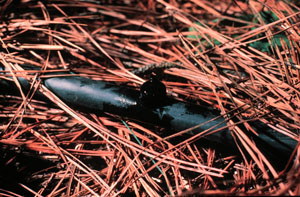 Figure 3. Drip irrigation saves water in the landscape and is ideal for ornamental plants. Do-it-yourself systems are available at most garden centers and are easy to install.
Figure 3. Drip irrigation saves water in the landscape and is ideal for ornamental plants. Do-it-yourself systems are available at most garden centers and are easy to install.To avoid run-off and water loss, apply water slowly to the base of the plant using a hand-held hose, drip or trickle irrigation, micro-sprinklers, or an ooze hose. Do-it-yourself irrigation systems, available from most garden centers, use 30 to 50 percent less water than sprinklers, and they can be attached directly to outdoor faucets.
The amount of water needed by an ornamental plant depends on the type of plant, the soil type, the amount of existing moisture in the soil, and the time of year. As a general rule, 6 gallons of water per 10 square feet of bed area or canopy area will saturate most soils to a depth of about 12 inches (the area containing 80 percent of the roots of most ornamental plants). Because water moves readily within the plant, you do not need to water the entire root zone. Twenty-five percent of the root area can absorb enough water for the entire plant.
The best time to water is at night or in the early morning. As much as 30 percent of the water applied during midday can be lost to evaporation accelerated by the sun.
Hydrogels (water-absorbing polymers), sold in garden centers under several different trade names, are popular products on the market. They absorb several hundred times their weight in water and release it slowly, as needed, to the plant. Research at The University of Georgia shows hydrogels may provide a significant growth benefit to summer annuals in non-irrigated soil.
Mulching
Mulches are a vital part of the Southern landscape. They hold moisture in the soil, help prevent weed growth, inhibit certain soil-borne foliar diseases, and insulate the roots of plants from temperature extremes during summer and winter. Mulch also provides a buffer zone between the turf and woody ornamental plants and helps prevent trunk injury from weed trimmers and lawn mowers.
The best mulch is organic, fine-textured and non-matting. Examples include pine needles (commonly called pine straw in the South), pine bark mini-nuggets, hardwood chips and cypress shavings. Fall leaves are an excellent and economical mulch and add valuable humus back to the soil as they decompose. Pecan hulls, a by-product of the pecan industry, are used successfully as mulch in south Georgia. Grass clippings are not a good source of mulch because they tend to mat down and inhibit the flow of water and nutrients into the soil. They also my introduce weeds into ornamental plantings. Inorganic mulches such as rock, gravel and marble are good soil insulators, but they absorb and re-radiate heat in the landscape, increasing water loss from plants. Limit their use to shady areas of the landscape.
Apply mulches 3 to 5 inches deep in an area extending beyond the canopy of the plant if possible. A small ring of mulch around the trunk provides little benefit to the plant.
Organic mulches such as pine straw or pine bark break down and decompose over time and should be replenished at least once a year.
Avoid placing plastic film under mulches; it prevents water, nutrients and oxygen from reaching the roots of the plant. Geo-textile (landscape fabric) can be used instead of plastic film under mulch. It allows water, nutrients and oxygen to reach the roots of plants and prevents the growth of some weeds. For best results, install landscape fabrics on weed-free ground and avoid getting soil on top of the fabric.
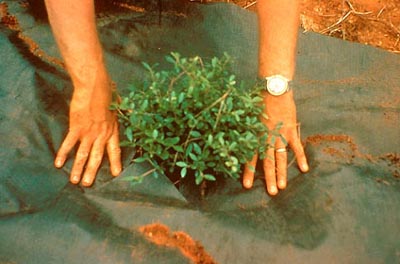 Figure 4. To install landscape fabric, roll it out over the top of newly planted shrubs, cut an X in it the size of the plant canopy, and push it down over the plant. Avoid gaps in the fabric by overlapping the strips of fabric 1 to 2 inches.
Figure 4. To install landscape fabric, roll it out over the top of newly planted shrubs, cut an X in it the size of the plant canopy, and push it down over the plant. Avoid gaps in the fabric by overlapping the strips of fabric 1 to 2 inches.
Pruning
Ornamental plants in landscapes are pruned for many reasons. We usually prune plants to achieve or maintain a certain size or form. At other times, we prune to remove old, diseased or damaged wood in an effort to promote vigorous new growth, flowering or fruiting.
Two basic pruning techniques are used to prune ornamental plants -- heading and thinning. Heading (also called heading back) refers to the non-selective removal of branches; thinning is the selective removal of branches back to a side branch or main trunk. Shearing is a form of heading.
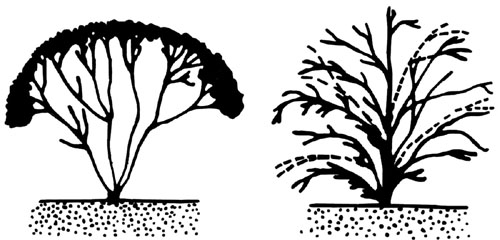 Figure 5. Thinning (right) results in an open canopy, improved air circulation and natural shape; shearing (left) encourages a dense outer canopy and unnatural form.
Figure 5. Thinning (right) results in an open canopy, improved air circulation and natural shape; shearing (left) encourages a dense outer canopy and unnatural form.Thinning is best for most ornamental plants because it opens up the plant canopy, increases air circulation within the plant, and results in a natural growth form. Shearing is frequently done on small-leaf evergreens such as boxwood and Japanese holly. Shearing is an efficient pruning technique, but it causes a thick outer canopy and loss of natural form.
If low-maintenance is your goal, keep shearing to a minimum in the landscape. Once you start shearing plants, you will have to shear them more frequently to keep them looking good. Selective thinning of branches once or twice a season is much less labor-intensive than monthly shearing.
Two ornamental plants in the landscape that are commonly sheared are liriope and ornamental grasses such as pampas grass. Shearing in late winter removes old growth and makes way for new shoots. An efficient way to prune liriope is with the lawn mower set at the highest possible setting.
Prune flowering ornamental plants at the proper time of year; otherwise flower buds might be removed. As a general rule, prune spring-flowering trees and shrubs soon after they bloom. Summer-flowering trees and shrubs bloom on new wood and are best pruned four to six weeks before spring growth begins. Table 4 provides suggested pruning times for several common flowering trees, shrubs and vines.
Some shade and flowering trees tend to bleed or excrete large amounts of sap from pruning wounds made in the early spring. Among these trees are maple, birch, dogwood, beech, elm, willow, flowering plum and flowering cherry. Sap excreted from the tree is not harmful, but it is unsightly. To minimize bleeding, prune these trees after the leaves have matured.
Avoid pruning during the fall or early winter because it may encourage tender new growth that is not sufficiently hardened to resist the winter cold.
Most broadleaf shrubs -- including azaleas, camellias, ligustrum, glossy abelia, nandina, cleyera and crepe myrtle -- will tolerate severe pruning when they overgrow their site or need rejuvenating. This involves cutting back the plant to within 12 inches of ground level. Boxwoods, junipers, pines, cypress, cedar, arborvitae, yews and other narrow-leaf evergreens do not respond favorably when severely pruned and may decline.
The best time to prune severely is when spring growth begins -- mid-March in north Georgia and mid-February in south Georgia. Avoid pruning severely from late fall to mid-winter since it increases the chances of cold injury to the plant.
| Table 4. Suggested pruning time for common flowering trees, shrubs and vines. | |||
| Prune after flowering: | |||
|
Azalea |
Deutzia Dogwood Doublefile Vibernum Flowering Almond Flowering Cherry Flowering Quince Forsythia Japanese Kerria |
Japanese Pieris Lilac Mockorange Oakleaf Hydrangea Pearlbush Pyracantha Redbud Saucer Magnolia |
Star Magnolia Shrub Honeysuckle Thunberg Spirea Weigela Winter Daphne Wisteria Witchhazel |
| Prune before spring growth begins: | |||
| Beautyberry Camellia Chaste Tree (Vitex) Cranberrybush Viburnum Crepe myrtle |
Floribunda Roses Fragrant Tea Olive Grandiflora Rosse Glossy Abelia Goldenrain Tree |
Japanese Barberry Japanese Spirea Mimosa Nandina |
Rose-of-Sharon (Althea) Sourwood Anthony Waterer Spirea Sweetshrub |
The following pruning guidelines are for selected ornamental plants in the landscape. For more detailed information on pruning, refer to the UGA Extension publication Pruning Ornamental Plants in the Landscape.
Arborvitae: The exterior foliage on this evergreen can be pruned lightly when it needs shaping. Avoid making major cuts.
Azalea: Prune by thinning after bloom if necessary. Don't prune at all if the plant looks good. Old overgrown plants can be renewed by being cut back close to ground level in February.
Beautyberry: Thin out growth before spring growth occurs. Flowers and fruits appear on new growth.
Birch: Make major cuts when dormant. Light pruning in full leaf will minimize sap flow (bleeding) from wound.
Boxwood: Prune by thinning or shearing almost any time of the year. Avoid heavy pruning because the plant is slow to recover and may decline.
Camellia: Thin out branches after bloom if necessary. Camellias generally require little pruning.
Cherry (Ornamental): Make major cuts in late winter. Use light pruning after bloom to remove suckers or to shape.
Clematis: Some of these plants bloom on old wood and some on new wood, depending on the species. It's best to wait until after bloom to prune this plant. Thin out the old wood. Some vigorous varieties can be pruned within 12 inches of ground level.
Cleyera: Prune by thinning during the growing season to maintain a natural shape.
Cotoneaster: Make thinning cuts to remove old wood and to shape in late winter or early spring.
Crabapple (Flowering): Prune when fully dormant to remove suckers and to produce a desirable shape. Young suckers can be easily removed by hand during the growing season.
Crape Myrtle: This plant flowers on new growth, so prune it when it is dormant. Make thinning and heading cuts to produce a desired form. For shrub forms, prune all branches close to ground level. For tree forms, save one to three of the most vigorous branches for the main trunk(s) and prune off low-growing branches to develop a tree-like growth habit.
Deutzia: Make thinning cuts after flowering if shaping is necessary.
Dogwood: This tree sets blossom buds in late summer. Make major cuts when dormant even though you may sacrifice some blossoms. Otherwise, prune it after flowering.
Elaeagnus: A very vigorous summer grower, it may grow a foot or more a week during the growing season. Thin out long shoots as necessary. Don't try to maintain a formal shape.
Euonymus: The growth habit of this plant ranges from upright shrubs to ground covers. Prune by thinning as necessary any time during the growing season.
Fringetree: Prune by thinning in late winter to achieve desired shape. Birds enjoy the late summer fruit, so avoid pruning after flowering.
Goldenrain Tree: Prune to tree form in late winter.
Hemlock: This plant normally needs no pruning. Light shearing of the outer canopy may be necessary to correct its form. Avoid major cuts.
Holly: There are many different growth habits and forms. Most are evergreen, but some species are deciduous. If plants are prized for berries, prune them in late winter, before spring flowering. If berries are not a concern, thinning (or shearing of small-leaf types) can be done any time during the growing season.
Honeylocust: Maintain desired shape by thinning in late winter.
Hydrangea (Bigleaf, French, Oakleaf): Flower buds form on old wood. Prune after flowering.
Hydrangea (Panicle, Smooth): Blooms form on new wood. Prune when dormant, and remove spent blossoms after flowering.
Jasmine (Winter): Thin out after flowering to maintain desired shape.
Juniper: Maintain shape or eliminate undergrowth of groundcover types by thinning during the growing season. Avoid heavy pruning to old wood because new growth will not occur.
Laurel (English): Prune by thinning as needed during the growing season.
Liriope: Remove old foliage four to six weeks before the spring growing season. On level ground, a lawn mower set to make the highest cut is an efficient way of pruning this plant.
Magnolia (Japanese): Prune to desired shape after flowering.
Magnolia (Southern): Generally requires little pruning. Shape by thinning during the growing season, preferably after bloom.
Maple: Prune in late winter if major cuts are necessary. Light pruning in mid-summer can also be done. Avoid early spring pruning because unsightly sap will flow from the pruning wounds.
Mockorange: Prune after flowering by thinning out old wood. The plant may be cut back to ground level if desired.
Mountain Laurel: Prune lightly by thinning to desired shape after flowering.
Nandina: As plants age, thin out old canes by cutting them back to ground level. Selectively cut back one-third of the remaining canes by half their length to encourage a full-dense canopy. Do this pruning in late winter or after fruiting.
Oak: Prune to desired shape when dormant.
Oleander: Flowers appear on new growth, so prune just prior to spring growth. Thin out old wood and head back top for desired shape and height.
Osmanthus: Shape by thinning during the growing season. The plant responds well to heavy pruning.
Pear (Ornamental): Make major cuts in late winter (when dormant), even though some blossoms may be sacrificed. Lightly prune after flowering if necessary.
Photinia (Red-tip): Prune any time during the growing season. Early spring and late summer pruning result in new growth that turns brilliant red.
Pine (Also spruce, fir): Prune to desired shape by removing all or part of the new growth (called candles) in spring. Avoid pruning into old wood.
Pittosporum: Prune to desired shape any time during the growing season.
Pyracantha: Prune after fruit set to remove non-fruiting wood.
Quince (Flowering): Prune after flowering. Thin out old branches and head back others to desired form and size.
Redbud: Make major cuts in late winter. Light pruning can be done after flowering.
Rhododendron: Prune, if necessary, to achieve desired shape and to increase branching after bloom.
Rose (Hybrid tea, grandiflora, floribunda): Prune in early spring when new growth begins.
Rose (Climbing): After flowering, thin out old canes and head back remaining shoots by about one-third, depending on their vigor.
Rose-of-Sharon: This plant flowers on new growth, so prune it in late winter.
Spirea: Prune by thinning after bloom. Most species respond well to severe pruning.
Trumpetcreeper: Flowers on new growth, so prune it during the dormant season. This plant will tolerate severe pruning.
Viburnum: Prune after flowering or fruit set to thin out oldest non-fruiting wood and to improve shape.
Waxmyrtle: Prune to desired shape during the growing season.
Wisteria: Prune after flowering. This is a very vigorous vine and it can be heavily pruned.
Witchhazel: Prune by thinning after flowering.
|
Improper method of
pruning crape myrtle |
Proper method of
pruning crape myrtle |
 1. Cutting on line shown by dashed line is too often done when pruning shrubs. 1. Cutting on line shown by dashed line is too often done when pruning shrubs. |
 1. Shrub before pruning. Remove all weak and dead branches. 1. Shrub before pruning. Remove all weak and dead branches. |
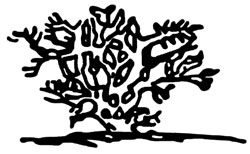 2. Same plant after being pruned as indicated above. All sucker growth remains. 2. Same plant after being pruned as indicated above. All sucker growth remains. |
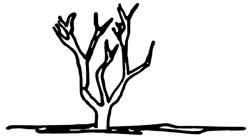 2. Same shrub after removal of weak and interfering branches and with base sucker growth removed. 2. Same shrub after removal of weak and interfering branches and with base sucker growth removed. |
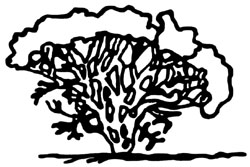 3. Final result: beautiful natural shape of shrub is lost and bloom is sparse and ineffectual. 3. Final result: beautiful natural shape of shrub is lost and bloom is sparse and ineffectual. |
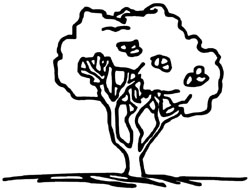 3. Final result: beautiful natural and distinctive form of plant retained. Vigorous growth and prolific and effective blooming. 3. Final result: beautiful natural and distinctive form of plant retained. Vigorous growth and prolific and effective blooming. |
|
The general pruning procedure illustrated above for pruning crepe myrtle also applies to many other large shrubs or small trees of similar structure.
|
|
Weed Control
Weeds in the landscape can be controlled mechanically (by hand, with mulch and landscape fabric) or chemically (with herbicides).
For chemical control, preemergence and post-emergence herbicides are available. Preemergence herbicides control weeds in the early stages of weed seed germination, and post-emergence herbicides are used to kill established weeds. Examples of preemergence herbicides are Dacthal, Surflan and Treflan. Commonly used post-emergence herbicides include Roundup (also called Kleenup or Blot-Out) and Vantage (formerly Poast). For specific detailed information on weed control, consult the Georgia Pest Management Handbook – Homeowner Edition.
Insect and Disease Management
Landscape plants are attacked by a diverse and complex group of insects and diseases. Management of these pests can be achieved by following these guidelines:
- Many insect and disease problems can be prevented by using plant materials that are seldom attacked or are less prone to pest problems. When buying new plant materials, consider the history of potential insect and disease problems for the plant before your purchase. Your county Extension office can help you with your selection.
- The best defense for pest problems is a healthy, actively growing, well-maintained plant. Follow proper management programs to maintain plant health.
- Monitor plants for pest problems on a regular basis, particularly during the growing season. Early detection of a pest problem will provide adequate time for control measures to be taken before the plant is extensively damaged.
- The correct diagnosis of a plant pest problem is the cornerstone of a successful control program and often requires careful study of the plant and surrounding environment. Diagnosis can often be based on symptoms expressed by the infested plant or by pests seen on the plant.
Diagnosis of some insect and mite problems often requires close examination of the plant. Chlorotic spots on leaves, a rust coloration of the upper leaf surface, or the silvering of the upper leaf surface may indicate the presence of mites, lace bugs or thrips. Curling or distortion of new plant growth, stunting of the plant, the presence of a sticky substance on the upper leaf surface, or a black sooty mold growing on the upper leaf surface indicate the presence of aphids, scale insects or whiteflies. These pests are small and difficult to detect when present in small numbers, so if a plant starts to show any of these symptoms, examine it closely for the presence of these pests.
Another sign of insect problems is the removal of plant tissues. Beetles, caterpillars, bagworms and grasshoppers damage landscape plants by removing the feeding on leaves. When holes are observed in leaves or portions of leaves, or when entire leaves are consumed, examine plants for the presence of one of these pests.
Insects such as borers, twig girders and leaf miners damage plants through their tunneling activities. Holes in the bark of trees, tunnels underneath the bark, tunneling activity in leaf tissue, dead terminal growth on a plant, or girdled twigs indicate an infestation of one of these pests.
The presence of strange plant growths, webbing or silk on plants can also indicate an insect or mite problem. Tent caterpillars and webworms construct silken webs or tents on their host plants. When spider mite populations become large, they cover their host plant with silken webbing. Gall insects often cause their host plants to produce abnormal growths on leaves, stems and twigs.
The presence of insects on ornamental plants does not always mean that control measures need to be taken. Non-pest insects may rest or hide on plants without posing a threat to plants. Light infestations of pest species can be controlled by beneficial insects or environmental factors and no additional control measure are needed. Healthy, actively growing plants can withstand some insect damage with no adverse long-term effects.
Once a pest problem has been properly diagnosed, a control program can be determined. If a chemical treatment is to be used as part of the control strategy, its effectiveness depends on strict adherence to the following: 1) apply the product when the pest is in a susceptible stage, 2) select a pesticide that is labeled for control of the insect application on the host plant, 3) closely follow label directions concerning dilution rates, 4) apply the product as specified on the label, and 5) apply the product to ensure good coverage of the host plant or target pest.
For more information on insect and mite identification and control recommendations, consult UGA Extension publication Control of Common Pests of Landscape Plants.
Be a Detective When Solving Plant Problems
Plants in the landscape cannot talk, but they will let you know when they are sick by the symptoms they express. Wilted or discolored leaves, dying branches and premature leaf drop are just a few of the symptoms of plant stress.
Often plant problems occur when a plant is not able to adapt to the site in which it is planted. For instance, junipers are extremely drought-tolerant once established, but they cannot tolerate poorly drained soils. Shade-loving plants like azalea, rhododendron and hosta often have problems when planted in areas that receive hot, mid-afternoon sun. Forcing plants to grow in harsh or unsuitable sites weakens them and encourages secondary insect and disease infestations.
At other times, plant problems result from poor cultural or management practices. We can literally kill plants with kindness by applying excess quantities of fertilizer or water. Planting too deeply is a common cultural mistake. When plants are set too deeply in the soil, the lower portion of the root
system becomes deprived of oxygen and dies. When attempting to diagnose and remedy a plant problem, be a detective and gather all the clues before attempting a cure. Ask yourself these questions:
- What has the recent weather pattern been? Has there been heavy rain or drought?
- Are other plants in the vicinity showing the same problem, or is this just an isolated case?
- What are the soil drainage patterns? Does the soil stay wet for a long period after rain or irrigation?
- What is the light level in the area and is the plant well-suited to the amount of light it receives?
- Has there been a chemical or fertilizer spilled in the vicinity of the plant?
- Have there been any chemicals sprayed on the plant recently?
If you cannot diagnose the problem, seek help from your county Extension agent or nurseryman. A sample of a live plant showing the symptoms and a soil sample (of at least 1 pint) taken from around the plant will help these professionals provide an accurate diagnosis of the plant problem. Taking the time to properly diagnose a plant problem before trying a cure will save you time, effort and money.
Trade and brand names are used only for information. Cooperative Extension, The University of Georgia College of Agricultural and Environmental Sciences, does not guarantee nor warrant published standards on any product mentioned; neither does the use of a trade or brand name imply approval of any product to the exclusion of others that also may be suitable.
Attention! Pesticide Precautions!
- Observe all directions, restrictions and precautions on pesticide labels. It is dangerous, wasteful and illegal to do otherwise.
- Store all pesticides in original containers with labels intact and behind locked doors. KEEP PESTICIDES OUT OF THE REACH OF CHILDREN.
- Use pesticides at correct label dosages and intervals to avoid illegal residues or injury to plants and animals.
- Apply pesticides carefully to avoid drift or contamination of non-target areas.
- Surplus pesticides and containers should be disposed of in accordance with label instructions so contamination of water and other hazards will not result.
- Follow directions on the pesticide label regarding restrictions as required by state and federal laws and regulations.
- Avoid any action that may threaten an endangered species or its habitat. Your county Extension agent can inform you of endangered species in your area, help you identify them and, through the Fish and Wildlife Service Field Office, identify actions that may threaten endangered species or their habitats.
Status and Revision History
Published on Oct 01, 2001
Published on Feb 26, 2009
Published with Full Review on Feb 16, 2012
Published with Full Review on Feb 16, 2016
Published with Full Review on May 27, 2020
Published with Full Review on Oct 10, 2022


























































